5. Value streams

Why it matters
As you scale, keeping customer focus while retaining speed becomes increasingly difficult. In the best case, this becomes apparent as growth pains. In the worst case, you discover too late that you have indeed drifted away from the customer, and investing yourself back to competitiveness would essentially cost you your market window. The trick is to grow in a smart way.
One of the organizational patterns particularly useful to address this situation is value streams. Value streams make scaling easier while retaining customer focus and speed. Organizing along value streams offers an opportunity and challenges leaders to shift their leadership stance to more strategic with a longer term perspective.
How it works
Scaling done without intent can drive accidental complexity. Let’s illustrate this.
Scaling by adding functions
One way to approach growth is by streamlining functions. This could, for example, mean that what was once a marketing person working closely with a business team could now be organized as its own function. The assumed benefit that this pattern brings is that it simplifies the training of new people. However, this comes with a price, which is often hidden from internal view: longer time to market, increased number of handovers and diluted customer value.
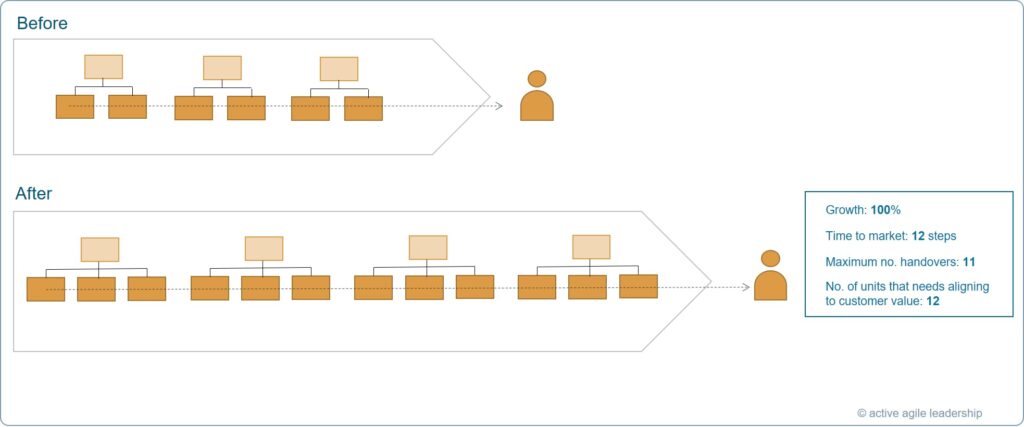
In this scaling pattern, we seek an increased degree of specialization, which results in adding more functions.
For large systems, organizing based on a pancake architecture often produces a similar result. Changes in the base layers of the architecture can have a long lead time, because they need to traverse all layers before being put in use by the customer. This effect is often hidden from view.
Scaling by duplicating value streams
Another way to approach growth is by keeping the value stream pattern. In this scenario, the original value steam is duplicated, with additional co-workers joining each. This pattern is well suited to support linear scaling (retaining time to market while growing).
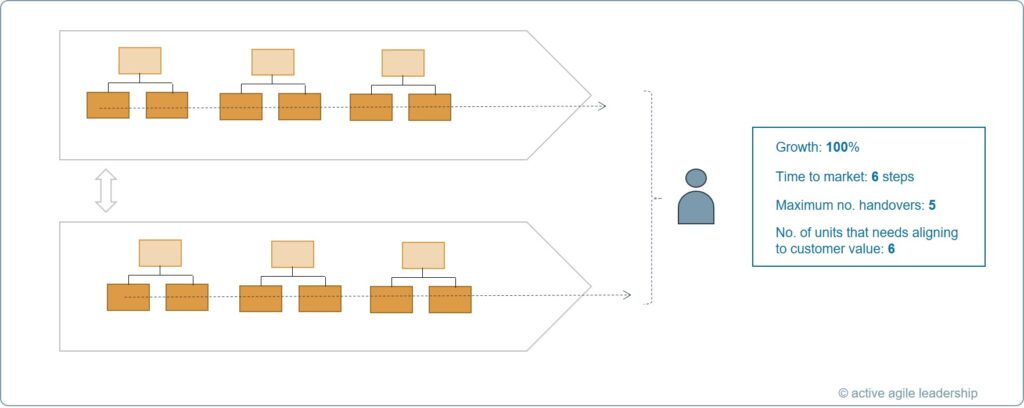
While there are several ways to look at advantages/disadvantages between the two patterns, at the end of the day, you have to ask: is this worth the added distance to the customer?
In the worst case scenario, if scaling “just happens” many times in a row without a clear intent of “how”, after some time, you might find that you have created an organization where no one is actually responsible for delivering customer value. The organization has now replaced customer demand with its own. Now, you have a serious case of accidental complexity.
When do I need to prepare to scale?
Well before your organizational size reaches roughly 150 people, you should have made up your mind about how to approach scaling. (The number 150 originates from the Dunbar Number, the size of a social group that we can hold meaningful relations with). While the exact number is up for debate, use this as a rough guide for when you have to act.
What is a value stream?
A value stream is an organizational unit with
- end-to-end capability to deliver value
- value/cost responsibility
- mandate to prioritize, in order to maximize value outcome

Setup conditions
- Size: 3-12 teams (~20 – 150 people)
- Teams are full-time citizens
○ Each team belongs to one value stream
○ Each team member belongs to one team
You normally don’t need an organizational unit like this unless you have more than 3 teams and plan to grow more. Below this, the team-based organization pattern combined with co-location normally fits the bill.
Let’s elaborate on the “full-time citizen” condition. The reason for this is to allow team members to focus. Focus is essential to creativity and productivity. If the ability to focus is taken away at the drawing board, then this is a sign that leaders are abandoning their responsibility to the people who work there and the quest to build a productive, engaging environment where great work can happen.
Will ability to focus have consequences? Yes. Does this require learning to build competence at a faster pace? Yes, and probably different from how you have done it until now. What the value stream organization does very effectively is highlight the competences and system capabilities you should improve on to stay productive. Solving them is up to you. The good news is that after repeating this process a few times, you will finally have improved your Organizational Agility – the ability to adapt to new conditions without much drama.
Value stream setup artifacts
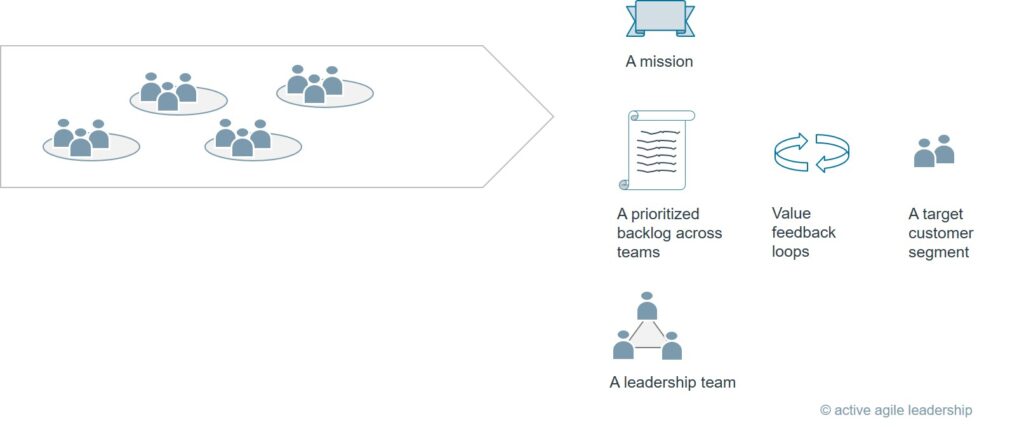
| A mission | This should contain an inspiring purpose and the raison d’être for the value stream. Good questions to ask when creating this include “what do we do best in the world?” and “what is the difference we are here to make?” |
| A prioritized backlog across teams | The value stream backlog is the process artifact, shared across all teams, through which we implement prioritization and trade-offs. |
| Value steam feedback cycles | The feedback cycles are how we learn if we are generating value. The feedback cycles are the essential link between our backlog and happy customers. Examples of customer feedback loops include: A/B testing, customer demos, social media feedback, usage diagnostics, to name a few. |
| A target customer segment | This is the target group that we are here to create value for. |
| A leadership team | The leadership team has value and delivery responsibilities and has the mandate to lay out the tactics to achieve the value stream mission. The leadership team can be formed using the leadership triad pattern (described here ). |
Good general practice – Decide what to optimize for
Value streams, with a mandate to prioritize, is a realization in organizational structure of the principle “Flow optimization”. You can form many different kinds of organizational setups, each will have pros and cons. The general rule is to figure out what you want to optimize for before setting the organizational structure. Think of it as setting priority guidelines for what you really value as a company when you are put under pressure.
It can be as simple as choosing and setting a stack ranked priority between these four principles:
- Value
- Flow optimization (delivery)
- Resource utilization
- Functional skill development.
If you manage to figure out the priorities among these four things, then setting an organization and supporting process that can make the value stream come alive becomes much easier. The lack of clarity in the priorities above often leads to a messy organizational setup.
A value stream represents making a priority bet on:
- Value,
- Flow optimization (delivery)
- Knowledge development
- Functional skill development.
Why? Because the value stream has the mandate to decide how best to realize its mission and what would make the customer segment fired up.
The cultural impacts of organizational structure
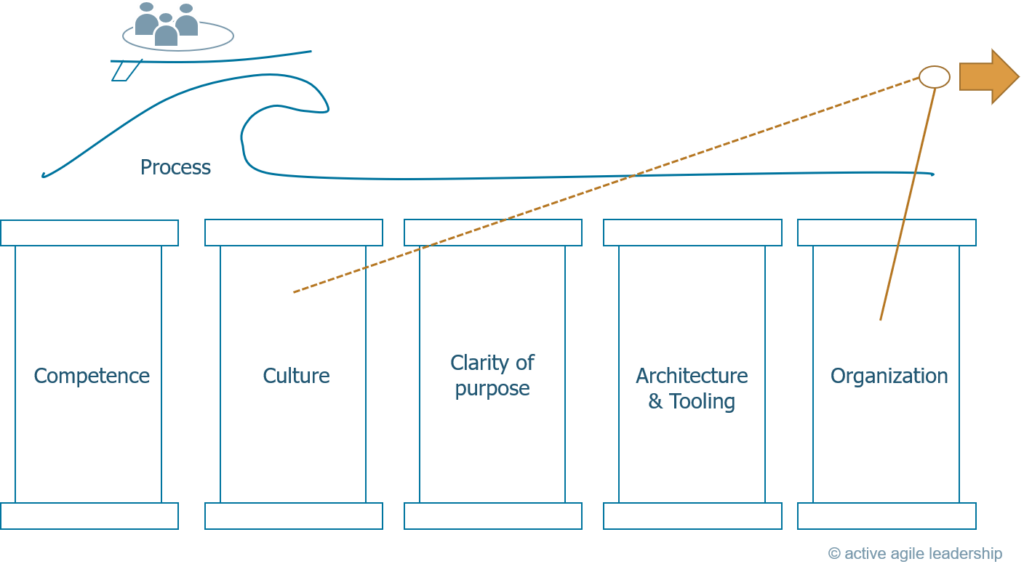
Your choice of organizational structure will have an impact on culture over time. So the recommended practice is that you should always consider the cultural shift you want to achieve together with your organizational setup. There is no free ride, all organizational setups have some cultural side effects, so it’s important to consider the cultural shift the company needs to evolve in both operations and mindset.
To illustrate this, here’s a list a few cultural impacts you may experience as a result of organizational structures.
| Function oriented & Resource utilization focused | While a functional oriented organization makes the job of managing functional competence in each unit easier, the cultural side effects are often ignored. Cultural impact: Emergence of what is sometimes dubbed “Fachidioten” – people who know a lot about a specific issue, but are clueless beyond their very narrow domain. They also become rather rigid and negative about what does not fit into their worldview. A function oriented/resource utilization focused organizational setup protects this thinking and inhibits responsibility towards shared purpose or value. |
| Flow optimization focused | Focus on flow efficiency and achieving shared objectives across functions. Cultural impact: Focus largely on internal operations and timely delivery to current customers, but lacking focus on addressing emerging market needs. |
| Value optimization focused | Customer learning oriented where focus is on learning about a specific set of problems for one customer. Cultural impact: Front-end heroism, focused on discovering opportunities but general lack of system thinking of the complexity beyond to make it happen. High enthusiasm on unearthing opportunities but lacking timely tradeoffs of what not to do. General lack of direction. |
Each of the cultural side effects can of course be mitigated, given that you are aware of them.
Good general practice – describe function before setting up an organization
Maybe you have your own favorite organization pattern. If so, then follow a good general practice: define function before the organization.
It’s easy to fall into the trap of advocating for a certain organization, and even setting up the roles and starting to hire people without ever having clearly defined the function it will serve. You know you are there when your peers advocate for “we need a [insert favorite name here] organization”. You are now adding accidental complexity.
The solution is simple: define the function before crafting the organization. The hidden benefit is that you might just find out that the better solution to the problem was to tweak the process or the architecture, not reshaping the organization!
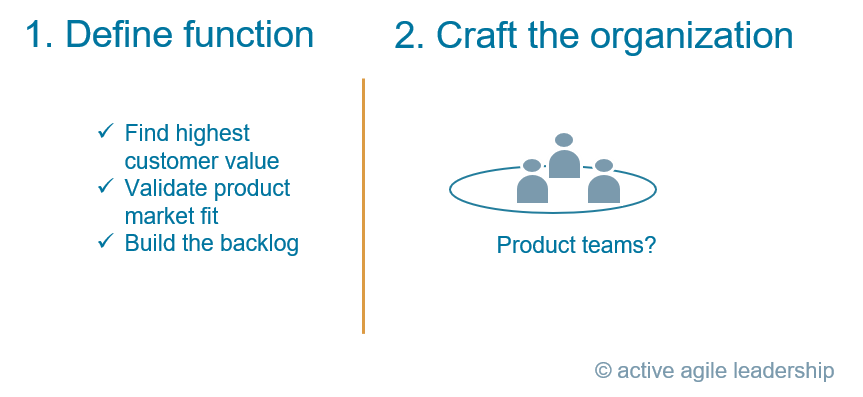
References
Value streams is an empirical based organizational pattern. To learn about how it works, you would need to look at the context of those specific companies. What many of these companies have in common is that they seek to enable growth and fast time to market.
In the study “Implementation and performance of a matrix organization structure”, the organisational setup”Hybrid Functional Matrix” (which shares many trademarks of Value streams), was evaluated. Improvements included:
“40% Reduction in time from opening of work order to award of construction contract in Street program”
“50% Improvement in annual capital program delivery in the Stormwater Program”
Value Streams, Wikipedia
“Implementation and performance of a matrix organization structure”, John A. Kuprenas, Department of Civil Engineering, University of Southern California
“The theory of Dunbar’s number holds that we can only really maintain about 150 connections at once. But is the rule true in today’s world of social media?”, Christine Ro, BBC, 2019
“Dunbar’s number doesn’t represent the average number of social connections”, David Burkus, 2018
“The Stupidity Paradox: The Power and Pitfalls of Functional Stupidity at Work”, Mats Alvesson, Mats, Spicer André, Profile Books, 2016